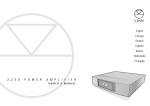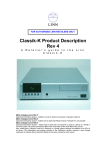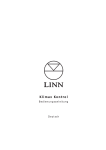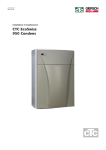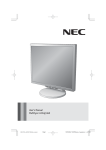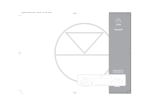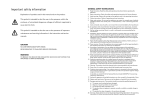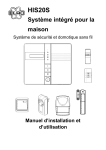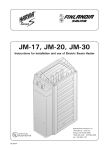Download Linn Line Receiver 2 User's Manual
Transcript
LINN DEKODA LINE RECEIVER 2 ROOMAMP 2 OWNER’S MANUAL MANUEL DU PROPRIÉTAIRE BEDIENUNGSANLEITUNG MANUALE DELL’ UTENTE MANUAL DEL USUARIO GEBRUIKERSHANDLEIDING .................................................. LINN DEKODA TEMPLATE - for learning remote-control commands (for the use of Linn-approved Custom Specialists only) MODELE - pour apprendre les commandes de télécommande (pour l'utilisation seulement par un spécialiste de personnalisation agrée Linn) MASKE - zum Lernen von Fernbedienungsbefehlen (Anwendung nur durch autorisierten Linn Installateur) SCHEMA - per l'apprendimento delle funzioni del telecomando (ad uso esclusivo dei rivenditori autorizzati Linn) PLANTILLA - para aprender comandos de control remoto (para el uso de Instaladores Personalizados aprobados por Linn, únicamente) MAL - om de commando's van de afstandsbediening te leren (alleen voor gebruik door een door Linn goedgekeurde Custom Specialist) 2 51mm / 2" LINN DEKODA 1 x4 x4 x4 x4 2 ? ? 3 Connection by Linn-approved Custom Specialist only Branchement seulement par un spécialiste de personnalisation agrée Linn Anschluss nur durch autorisierten Linn Installateur La connessione deve essere configurata da un rivenditore autorizzato Linn Conexión por Instalador Personalizado aprobado por Linn, únicamente Aansluiting alleen door een door Linn goedgekeurde Custom Specialist 3 LINN DEKODA Technical Specification Caractéristiques Techniques Technischen Daten Caratteristiche tecniche Especificaciones Técnicas Technishe specificatie 4 INPUTS ENTRÉES EINGÄNGE INGRESSE ENTRADAS INGANGEN REMOTE RCA PHONO RCU RJ45 RS232 RJ11 OUTPUTS SORTIES AUSGÄNGE USCITE SALIDAS UITGANGEN REMOTE RCA PHONO RCU RJ45 RS232 RJ11 FLASHER 3.5mm JACK 0.14" JACK DIMENSIONS DIMENSIONS ABMESSUNGEN DIMENSIONI DIMENSIONES AFMETINGEN 244mm x 180mm x 45mm 9.61" x 7.1" x 1.77" WEIGHT POIDS GEWICHT PESO PESO GEWICHT 1Kg 2.2lb LINE RECEIVER 2 1 x4 x4 x4 x4 2 ? ? ? RAKK LR2 3 Connection by Linn-approved Custom Specialist only Branchement seulement par un spécialiste de personnalisation agrée Linn Anschluss nur durch autorisierten Linn Installateur La connessione deve essere configurata da un rivenditore autorizzato Linn Conexión por Instalador Personalizado aprobado por Linn, únicamente Aansluiting alleen door een door Linn goedgekeurde Custom Specialist 5 LINE RECEIVER 2 Technical Specification Caractéristiques Techniques Technischen Daten Caratteristiche tecniche Especificaciones Técnicas Technishe specificatie INPUTS ENTRÉES EINGÄNGE INGRESSE ENTRADAS INGANGEN REMOTE AUDIO IN (1-3) RCA PHONO RCU ROOM RCU SUB ZONE MAIN ROOM IN RJ45 RS232 RJ11 OUTPUTS SORTIES AUSGÄNGE USCITE SALIDAS UITGANGEN REMOTE TAPE OUT ROOM OUT SUB ZONE OUT PHONES 6mm JACK 0.25" JACK IMPEDANCE IMPÉDANCE IMPEDANZ IMPEDANZA IMPEDANCIA IMPEDANTIE ROOM OUT 300Ω SUB ZONE OUT 300Ω PHONES <16Ω RCA PHONO TRIGGER (V) 12V MAINS SUPPLY RANGE PLAGE D'ALIMENTATION SECTEUR NETZSPANNUNGSBEREICH TENSIONE DI ALIMENTAZIONE GAMA DE ALIMENTACIÓN VOLTAGEBEREIK VAN NETSPANNING 100Vac – 240Vac; 50Hz/60Hz POWER CONSUMPTION CONSOMMATION LEISTUNGSAUFNAHME ASSORBIMENTO CONSUMO ENERGIEVERBRUIK 10W max; 5W nom DIMENSIONS DIMENSIONS ABMESSUNGEN DIMENSIONI DIMENSIONES AFMETINGEN 345mm x 274mm x 44.45mm 13.58" x 10.79" x 1.75" WEIGHT POIDS GEWICHT PESO PESO GEWICHT 2Kg 4.4lb RACK 6 1U ROOMAMP 2 1 x4 x4 x4 x4 x4 2 ? Ventilation required for heat dissipation Aération recommandée pour dissipation de chaleur Zur Wärmeableitung ist Belüftung nötig Ventilazione richiesta per la dissipazione del calore Se precisa ventilación para disipar el calor Ventilatie noodzakelijk om warmte te verdrijven ? Ventilation required for heat dissipation Aération recommandée pour dissipation de chaleur Zur Wärmeableitung ist Belüftung nötig Ventilazione richiesta per la dissipazione del calore Se precisa ventilación para disipar el calor Ventilatie noodzakelijk om warmte te verdrijven Ventilation required for heat dissipation Aération recommandée pour dissipation de chaleur Zur Wärmeableitung ist Belüftung nötig Ventilazione richiesta per la dissipazione del calore Se precisa ventilación para disipar el calor Ventilatie noodzakelijk om warmte te verdrijven ? RAKK RA2 3 Connection by Linn-approved Custom Specialist only Branchement seulement par un spécialiste de personnalisation agrée Linn Anschluss nur durch autorisierten Linn Installateur La connessione deve essere configurata da un rivenditore autorizzato Linn Conexión por Instalador Personalizado aprobado por Linn, únicamente Aansluiting alleen door een door Linn goedgekeurde Custom Specialist 7 ROOMAMP 2 Technical Specification Caractéristiques Techniques Technischen Daten Caratteristiche tecniche Especificaciones Técnicas Technishe specificatie 8 REMOTE AUDIO IN (1-3) RCA PHONO RCU ROOM RCU SUB ZONE MAIN ROOM IN RJ45 RS232 RJ11 OUTPUTS SORTIES AUSGÄNGE USCITE SALIDAS UITGANGEN REMOTE TAPE OUT ROOM OUT SUB ZONE OUT RCA PHONO PHONES 6mm JACK 0.25" JACK IMPEDANCE IMPÉDANCE IMPEDANZ IMPEDANZA IMPEDANCIA IMPEDANTIE ROOM OUT 300Ω SUB ZONE OUT 300Ω PHONES <16Ω INPUTS ENTRÉES EINGÄNGE INGRESSE ENTRADAS INGANGEN OUTPUT POWER PUISSANCE DE SORTIE AUSGANGSLEISTUNG POTENZA DI USCITA POTENCIA DE SALIDA UITGANGSVERMOGEN 20W / ch 4Ω LOAD TOLERANCE TOLÉRANCE DE CHARGE LASTTOLERANZ TOLLERANZA DI CARICO TOLERANCIA DE CARGA BELASTINGSTOLERANTIE 8Ω – 2Ω TRIGGER (V) 12V MAINS SUPPLY RANGE PLAGE D'ALIMENTATION SECTEUR NETZSPANNUNGSBEREICH TENSIONE DI ALIMENTAZIONE GAMA DE ALIMENTACIÓN VOLTAGEBEREIK VAN NETSPANNING 100Vac – 240Vac; 50Hz/60Hz POWER CONSUMPTION CONSOMMATION LEISTUNGSAUFNAHME ASSORBIMENTO CONSUMO ENERGIEVERBRUIK 10W max; 5W nom DIMENSIONS DIMENSIONS ABMESSUNGEN DIMENSIONI DIMENSIONES AFMETINGEN 345mm x 274mm x 44.45mm 13.58" x 10.79" x 1.75" WEIGHT POIDS GEWICHT PESO PESO GEWICHT 2.25Kg 4.96lb RACK 1U Important Safety Information Explanation of symbols used in this manual and on the product: This symbol is intended to alert the user to the presence of uninsulated dangerous voltages within the enclosure sufficient magnitude to cause electric shock. This symbol is intended to alert the user to the presence of important operation, maintenance and servicing information in the instruction and service manuals. CAUTION TO REDUCE THE RISK OF ELECTRIC SHOCK DO NOT REMOVE THE COVER. NO USER SERVICEABLE PARTS INSIDE. REFER SERVICING TO QUALIFIED SERVICE PERSONNEL. REPLACE THE MAINS FUSE IN THE PLUG WITH ONE OF THE SAME TYPE AND RATING. DISCONNECT SUPPLY CORD BEFORE CHANGING FUSE. WARNING TO REDUCE THE RISK OF FIRE OR ELECTRIC SHOCK DO NOT EXPOSE THIS APPLIANCE TO RAIN OR MOISTURE. SHOCK HAZARD. DO NOT OPEN. MAINS PLUGS This appliance is supplied with a non-rewireable mains plug for the intended country. Replacement mains leads can be obtained from your Linn retailer. Should you need to change the plug please dispose of it carefully. A plug with bared conductors is dangerous if engaged in a live socket. The Brown wire must be connected to the Live (Line) supply pin. The Blue wire must be connected to the Neutral supply pin. The Green/Yellow wire must be connected to the Earth (Ground) supply pin. Please contact your retailer or a competent electrician if you are in any doubt. Disconnect the product from the mains supply using the mains plug. The mains plug must be accessible at all times. GENERAL SAFETY INSTRUCTIONS 1. Read instructions. Read the safety and operating instructions before operating the appliance. 2. Retain instructions. Retain the safety and operating instructions for future reference. 3. Heed warnings. Observe all warnings on the appliance and in the operating instructions. 4. Follow instructions. Follow all operating and use instructions. 5. Water and moisture. Do not use the appliance near water, for example near a bathtub, wash bowl, kitchen sink, laundry tub, in a wet basement, or near a swimming pool and the like. 6. Carts and stands. Use only with a cart or stand that is recommended by the manufacturer. 6a. An appliance and cart combination should be used with care. Quick stops, excessive force, and uneven surfaces may cause the appliance and cart combination to overturn. 7. Wall or ceiling mounting. Mount to a wall or ceiling only as recommended by the manufacturer. 8. Ventilation. Site the appliance so that its location or position does not interfere with its proper ventilation. For example, the appliance should not be situated on a bed, sofa, rug, or similar surface that may block the ventilation openings, or placed in a built-in installation such as a bookcase or cabinet that may impede the flow of air through the ventilation openings. 9. Heat. Site the appliance away from heat sources such as radiators, heaters, stoves, or other appliances (including amplifiers) that produce heat. 10. Power sources. Connect the appliance to a power supply only of the type described in the operating instructions or marked on the appliance. 11. Grounding or polarisation. Do not defeat the safety purpose of the polarised or grounding type plug. A polarised plug has two blades with one wider than the other. A grounding type plug has two blades and a third grounding prong.The wide blade or the third prong is provided for your safety. When the provided plug does not fit into your outlet, consult an electrician for replacement of the obsolete outlet. 12. Power cord protection. Route power cords so that they are not likely to be walked on or pinched by items placed upon or against them, paying particular attention to cords at plugs, power sockets, and at the point where they exit from the appliance. 13. Protective attachment plug. As a safety feature the product is equipped with an attachment plug containing overload protection. See the instruction manual about resetting or replacing the plug. Should the plug need replacing ensure that a replacement is used which has the same overload protection as the original. 14. Cleaning. The product should be cleaned only as recommended by the manufacturer. 15. Power lines. An outdoor antenna should be located away from power lines. 16. Outdoor antenna grounding. If an outdoor antenna is connected to the tuner/receiver, ensure that the antenna system is grounded to provide some protection against voltage surges and static build up. In the USA see article 810 of the National Electrical Code ANSI/NFPA 70 concerning installation requirements. 17. Lightning storms. Unplug this apparatus during lightning storms or when unused for long periods of time. 18. Objects and liquid entry. Do not let objects or liquids fall into the product.Do not expose the product to dripping or splashing. Do not place a vessel containing liquid on top of the product. 19. Damage requiring service. The product should be serviced by qualified personnel if: a) The power cord or plug has been damaged. b) Objects or liquid have fallen into the product. c) The product has been exposed to rain. d) The product does not appear to operate normally or exhibits a marked change in operation. e) The product has been dropped or the enclosure damaged. 20. Servicing. Do not attempt to service the product beyond that described in the operating instructions. All other servicing should be referred to qualified service personnel. UK USERS PLEASE READ THIS IMPORTANT SAFETY INFORMATION Fuse replacement This appliance is fitted with a non-rewireable 13 Amp mains plug.The plug contains a 5 Amp fuse. If the fuse has blown it can be replaced as follows: a) Pull out the red fuse cover/carrier. b) Remove and dispose of the blown fuse. c) Fit a new 5 Amp BS1362 approved fuse into the carrier and push the carrier back into the plug. Always ensure the fuse cover is fitted. If the fuse cover is missing do not use the plug. Contact your Linn retailer to obtain a replacement fuse cover. Fuses are for fire protection and do not protect against electric shock. Mains plug replacement Should your mains plug need replacing and you are competent to do this proceed as follows. If you are in doubt contact your Linn retailer or a competent electrician. a) Disconnect the plug from the mains supply. b) Cut off the plug and dispose of it safely. A plug with bared conductors is dangerous if engaged in a live socket. c) Only fit a 13 Amp BS1363A approved plug with a 5 Amp fuse. d) The cable wire colours or a letter will be marked at the connection points of most quality plugs. Attach the wires securely to their respective points.The Brown wire must go to the Live pin, the Blue wire must go to the Neutral pin, and the Green/Yellow wire must go to the Earth pin. e) Before replacing the plug top ensure that the cable restraint is holding the outer sheath of the cable firmly and that the wires are correctly connected. WARNING THIS APPLIANCE MUST BE EARTHED. CE Declaration of Conformity Linn Products Ltd declare that this product is in conformance with the Low Voltage Directive 73/23/EEC and Electromagnetic Compatibility 89/336/EEC as amended by 92/31/EEC and 93/68/EEC.. The conformity of the designated product with the provisions of Directive number 73/23/EEC (LVD) is proved by full compliance with the following standards: Standard number EN60065 Date of issue 2002 Test type General requirements Marking Hazardous radiation Heating under normal conditions Shock hazards under normal o perating conditions Insulation requirements Fault conditions Mechanical strength Parts connected to the mains supply Components Terminal devices External flexible cords Electrical connections and mechanical fixings Protection against electric shock Stability and mechanical hazards Resistance to fire The conformity of the designated product with the provisions of Directive number 89/336/EEC (EMC) is proved by full compliance with the following standards: Standard number EN55013 EN55013 EN55020 Date of issue 2001 2001 2002 Test type Conducted emissions Absorbed emissions Immunity FCC notice NOTE: This equipment has been tested and found to comply with the limits for a Class B digital device, pursuant to Part 15 of the FCC Rules.These limits are designed to provide reasonable protection against harmful interference in a residential installation.This equipment generates, uses and can radiate radio frequency energy and, if not installed and used in accordance with the instructions,may cause harmful interference to radio communications. However, there is no guarantee that interference will not occur in a particular installation. If this equipment does cause harmful interference to radio or television reception, which can be determined by turning the equipment off and on, the user is encouraged to try to correct the interference by one or more of the following measures: • Reorient or relocate the receiving antenna. • Increase the separation between the equipment and receiver. • Connect the equipment into an outlet on a circuit different from that to which the receiver is connected. • Consult the dealer or an experienced radio/TV technician for help. 9 Instructions de Securite Explication des symboles utilisés dans ce manuel et sur le produit : Ce symbole avertit l’utilisateur de la présence d’une tension dangereuse localisée à l’intérieur du carter de l’appareil et pouvant être suffisamment élevée pour présenter un risque de choc électrique. Ce symbole informe l’utilisatur que ce manuel contient des instructions importantes concernant l’entretien et le dépannage. ATTENTION AFIN DE LIMITER LE RISQUE DE CHOC ELECTRIQUE, NE PAS RETIRER LE CAPOT. L’NTERIEUR NE COMPORTE QUE DES COMPOSANTS REPARABLES PAR UN SPECIALISTE. EN CAS DE PROBLEME CONTACTER UN REPARATEUR AGREE. ATTENTION : UTILISER UN FUSIBLE DE RECHANGE DE MEME TYPE. ATTENTION : DEBRANCHER AVANT DE REMPLACER LE FUSIBLE. AVERTISSEMENT AFIN DE LIMITER LE RISQUE D’INCENDIE OU DE CHOC ELECTRIQUE, NE PAS EXPOSER CET APPAREIL A LA PLUIE OU A L’HUMIDITE. AVIS : RISQUE DE CHOC ELECTRIQUE. NE PAS OUVRIR. FICHES SECTEURS Cet appareil est livré avec une fiche secteur non démontable adaptée aux normes électriques du pays d’utilisation. Procurez-vous des cordons de secteur de remplacement auprès de votre revendeur Linn. Si vous devez remplacer la fiche, manipulez-la avec soin. Une fiche présentant des conducteurs nus est dangereuse si elle est branchée dans une prise sous tension. Le fil marron doit être connecté à la broche de ligne sous tension. Le fil bleu doit être connecté à la broche du neutre. Le fil vert/jaune doit être connecté à la broche de la masse. En cas de doute, veuillez contacter votre revendeur ou un électricien qualifié. 10 INSTRUCTIONS DE SECURITE à l’intention des utilisateurs résidant au Royaume-Uni Remplacement du fusible Cet appareil est livré avec une fiche secteur non démontable de 13 A. La fiche comporte un fusible de 5 A. Si le fusible a sauté, remplacez-le en suivant la procédure ci-dessous : a) Ouvrez le compartiment du fusible. b) Retirez le fusible endommagé. c) Remplacez-le par un fusible neuf de 5 A conforme à la norme BS1362 et refermez le compartiment fusible. Vérifiez que le compartiment a été correctement refermé. Si le couvercle du logement est absent, n’utilisez pas la fiche. Procurez-vous un autre couvercle auprès de votre revendeur Linn. Les fusibles servent à protéger contre les incendies, mais en aucun cas contre les risques de choc électrique. Remplacement de la fiche secteur Si vous devez remplacer la fiche secteur et ne vous sentez pas suffisamment compétent pour le faire, adressez-vous à votre revendeur Linn ou à un électricien qualifié. a) Débranchez la fiche de l’alimentation secteur. b) Coupez la fiche et placez-la en lieu sûr.Une fiche présentant des fils dénudés est dangereuse si elle est branchée dans une prise sous tension. c) Seule une fiche de 13 A conforme à la norme BS1363A avec un fusible de 5 Amp peut être utilisée. d) La couleur des fils du câble ou une lettre sera indiquée sur les bornes de contact de la plupart des fiches de bonne qualité. Fixez chaque fil sur la borne qui lui correspond. Reliez le fil marron au secteur, le fil bleu au neutre et le fil vert/jaune à la terre. e) Avant de replacer le couvercle de la fiche, assurez-vous que la gaine du câble pénètre bien dans la fiche et qu’elle est fermement maintenue. Vérifiez également que les fils ont été connectés correctement. INSTRUCTIONS GENERALES DE SECURITE ATTENTION 1. Veuillez lire toutes les instructions de sécurité et de fonctionnement avant d’utiliser l’appareil. 2. Veuillez conserver les instructions de sécurité et de fonctionnement pour pouvoir vous y reporter ultérieurement. 3. Tenez compte des avertissements. Respectez tous le avertissements figurant sur l’appareil et sur la notice d’utilisation. 4. Suivez les instructions. Suivez toutes les instructions relatives à l’utilisation et au fonctionnement. 5. Eau et humidité. N’utilisez pas cet équipement à proximité d’une baignoire, d’une bassine, d’un évier, d’une cuve à lessive, dans un sous-sol humide, près d’une piscine ou de toute autre source d’humidité. 6. Chariots et socles. Placez ce système uniquement sur un chariot ou sur un socle recommandé par le fabricant. 6a. L’ensemble appareil-chariot doit être déplacé avec précaution. Il peut basculer en cas d’arrêt brusque, de poussée excessive ou de parcours accidenté. 7. Montage au mur ou au plafond. Suivez scrupuleusement les recommandations du fabricant si vous décidez de fixer le système au mur ou au plafond. 8. Ventilation. Positionnez l’appareil de façon à ne pas obstruer sa ventilation. Ne le posez pas sur un lit, un canapé, un tapis ou autre surface similaire, car les ouvertures prévues pour la ventilation pourraient être bloquées.Ne le placez pas dans un meuble encastré (bibliothèque ou placard, par exemple) car cela risquerait également d’empêcher la circulation de l’air à travers les évents. 9. Chaleur. Eloignez l’appareil de toute source de chaleur : radiateurs, chauffe-eau, poêles, ou tout autre appareil électrique (y compris un amplificateur) produisant de la chaleur. 10. Alimentation électrique. Connectez l’appareil à une source de courant adéquate, en suivant les instructions de fonctionnement ou d’utilisation inscrites sur l’appareil. 11. Raccord à la masse ou polarisation. Ne touchez pas au dispositif de sécurité de raccordement à la masse et de polarité. Une fiche polarisée a une broche plus épaisse que l’autre. Une fiche de terre a trois broches : une pour le neutre, une pour la phase, une pour la terre. La broche de mise à la masse est prévue pour votre sécurité. Si la fiche fournie ne correspond pas à la prise de secteur, consultez un électricien et faites remplacer votre prise murale. 12. Protection du cordon d’alimentation. Placez les cordons d’alimentation électriques afin qu’on ne puisse pas marcher dessus ni les écraser. Prenez grand soin des cordons, en particulier au niveau des fiches, des prises murales et à la sortie de l’appareil. 13. Fiche de raccordement de protection. Dans un souci de sécurité, ce produit a été équipé d’une fiche de raccordement dotée d’une protection contre les surtensions. Reportez-vous aux instructions relatives au remplacement ou au réenclenchement de la fiche. Si la fiche doit être remplacée, veillez à ce que la nouvelle fiche soit également munie d’une protection contre les surtensions. 14. Nettoyage. Nettoyez l’appareil en suivant les recommandations du fabricant. 15. Périodes de non-utilisation. Débranchez le cordon d’alimentation de la prise murale si vous avez l’intention de ne pas utiliser l’appareil pendant une longue période. 16. Pénétration d’objets et de liquides. Veillez à ce qu’aucun objet ne tombe à l’intérieur et qu’aucun liquide ne coule dans l’appareil. 17. Dégâts exigeant une réparation. Le système doit être confié à un réparateur agréé si: a) le cordon d’alimentation électrique ou la fiche ont été endommagés, b) des objets sont tombés à l’intérieur ou un liquide a été répandu dans l’appareil, c) l’équipement a été exposé à la pluie, d) il ne semble pas fonctionner normalement ou présente un changement notoire de performance ou e) le système est tombé ou son boîtier a été endommagé. 18. Réparations. N’essayez en aucun cas de réparer ce système vous-mêmes. Conformezvous aux instructions de fonctionnement.Toute intervention doit être confiée à un réparateur agréé. CET APPAREIL DOIT ETRE RELIE A LA TERRE. Déclaration de conformité pour la CE Linn Products Ltd déclare que ce produit est conforme aux directives 73/23/CEE sur la basse tension et 89/336/CEE sur la compatibilité électromagnétique,modifiées par les directives 92/31/CEE et 93/68/CEE. La conformité du produit ainsi désigné aux clauses de la directive n° 73/23/CEE (sur la basse tension) est confirmée par le respect total de toutes les normes suivantes : Numéro de norme EN60065 Date de publication 1998 Type d'essai Obligations générales Marquage Rayons dangereux Chauffage dans des conditions normales Danger de chocs électriques dans des conditions opérationnelles normales Critères d'isolement Conditions d'anomalie Robustesse mécanique Pièces raccordées à l'alimentation secteur Composants Dispositifs du type bornes Cordons électriques externes Raccordements électriques et fixations mécaniques Protection contre les chocs électriques Stabilité et dangers mécaniques Résistance au feu La conformité du produit désigné aux clauses de la directive n° 89/336/CEE (compatibilité électromagnétique) est confirmée par le respect total de toutes les normes suivantes : Numéro de norme EN55013 EN55013 EN55020 Date de publication 2001 2001 2002 Type d'essai Emissions conduites Emissions absorbées Immunité Déclaration FCC REMARQUE: Cet équipement a été testé et déclaré conforme aux limitations prévues dans le cadre de la catégorie B des appareils numériques défini par la section 15 du règlement de la FCC. Ces limitations sont stipulées aux fins de garantir une protection raisonnable contre les interférences gênantes en installation résidentielle. Cet équipement génère, utilise et diffuse des ondes radio, et s’il n’est pas installé ni utilisé en conformité avec les instructions dont il fait l’objet, peut causer des interférences gênantes avec les communications radio. Cependant, nous ne pouvons vous garantir qu’une interférence ne se produira pas dans une installation particulière. Si cet équipement produit des interférences graves, lors de réceptions radio ou télévisées qui peuvent être détectées en allumant et en éteignant l’équipement, vous êtes invités à les supprimer de plusieurs manières: • Réorientez ou déplacez l'antenne de réception. • Augmentez la distance séparant l’équipement et le récepteur. • Connectez l’équipement à un circuit différent de celui du récepteur. • Contactez votre revendeur ou un technicien radio/TV qualifié. Wichtige Sicherheitsinformationen Allgemeine Sicherheitsanweisungen Erläuterung der Symbole, die in dieser Bedienungsanleitung und auf dem Produkt verwendet werden: 1. Lesen Sie die Anweisungen. Lesen Sie die Sicherheitsanweisungen und die Bedienungsanleitung, bevor Sie das Gerät bedienen. 2. Bewahren Sie die Bedienungsanleitung auf. Bewahren Sie die Sicherheitsanweisungen und die Bedienungsanleitung auf, um später darin nachlesen zu können. 3. Beachten Sie die Warnhinweise. Berücksichtigen Sie alle Warnhinweise am Gerät und in der Bedienungsanleitung. 4. Befolgen Sie die Anleitungen. Halten Sie sich an alle Bedienungs- und Gebrauchsanweisungen. 5. Wasser und Feuchtigkeit. Betreiben Sie das Gerät nicht in der Nähe von Wasser, beispielsweise in der Nähe einer Badewanne, einer Waschschüssel, eines Spülbeckens, einer Waschtrommel, in einem feuchten Keller, in der Nähe eines Schwimmbeckens oder in der Nähe ähnlicher Einrichtungen. 6. Wagen und Gestelle. Verwenden Sie nur Wagen oder Gestelle, die vom Hersteller empfohlen werden. 6a. Eine Kombination aus Gerät und Wagen muss mit Vorsicht verwendet werden. Schnelles Abbremsen, übermäßige Krafteinwirkung und unebene Oberflächen führen möglicherweise dazu, dass der Wagen mit dem Gerät umstürzt. 7. Wand- oder Deckenmontage. Eine Wand- oder Deckenmontage sollte nur entsprechend der Herstellerempfehlung durchgeführt werden. 8. Belüftung. Stellen Sie das Gerät so auf, dass der Standort oder die Position eine ordnungsgemäße Belüftung nicht beeinträchtigt. Beispielsweise darf das Gerät nicht auf einem Bett, Sofa,Teppich oder einer ähnlichen Oberfläche aufgestellt werden, durch die die Belüftungsöffnungen blockiert werden. Es darf auch nicht in einem umschlossenen Raum wie etwa in einem Bücherregal oder Schrank so aufgestellt werden, dass die Luftströmung durch die Belüftungsöffnungen behindert wird. 9. Wärme. Stellen Sie das Gerät nicht in der Nähe von Wärmequellen auf, z. B. in der Nähe von Radiatoren, Heizungen, Öfen oder anderen Geräten (einschließlich Verstärkern), die Wärme erzeugen. 10. Stromanschluss. Schließen Sie das Gerät nur an eine Stromversorgung des Typs an, der in der Bedienungsanleitung beschrieben oder auf dem Gerät angegeben ist. 11. Erdung oder Unvertauschbarkeit. Setzen Sie den Sicherheitszweck von unvertauschbaren oder Erdungssteckern nicht außer Kraft. Ein unvertauschbarer Stecker besitzt zwei Messerkontakte, von denen einer breiter als der andere ist. Ein Erdungsstecker besitzt zwei Messerkontakte und einen dritten Erdungskontakt.Der breitere Messerkontakt oder der Erdungskontakt dient Ihrer Sicherheit.Wenn der mitgelieferte Stecker nicht in Ihre Steckdosen passt, wenden Sie sich an einen Elektriker, damit er die veralteten Steckdosen austauscht. 12. Schutz des Netzkabels. Ein Netzkabel muss so verlegt werden, dass niemand auf das Kabel treten kann und dass es nicht durch Objekte gequetscht wird, die auf das Kabel gestellt werden oder dagegen drücken. Achten Sie besonders auf die Stellen, an denen Kabel aus Steckern, Steckdosen und dem Gerät herausgeführt werden. 13. Schutzstecker. Das Produkt ist zur Sicherheit mit einem Stecker ausgerüstet, der einen Überlastschutz enthält. In der Bedienungsanleitung finden Sie Informationen darüber, wie der Stecker zurückgesetzt oder ausgetauscht wird. Sollte der Stecker ausgetauscht werden müssen, achten Sie darauf, dass der Ersatzstecker denselben Überlastschutz wie der ursprüngliche Stecker enthält. 14. Reinigung. Das Produkt darf nur gemäß den Herstellerempfehlungen gereinigt werden. 15. Starkstromleitungen. Eine Außenantenne darf nicht in der Nähe von Starkstromleitungen installiert werden. 16. Erdung der Außenantenne. Wenn Sie eine Außenantenne an den Tuner/Receiver anschließen, achten Sie darauf, das Antennensystem zu erden, damit ein Schutz gegen Spannungsspitzen und den Aufbau statischer Elektrizität vorhanden ist. In den Vereinigten Staaten muss Paragraph 810 der Elektrobestimmungen ANSI/NFPA 70 in Bezug auf Installationsanforderungen eingenhalten werden. 17. Gewitter. Ziehen Sie den Netzstecker dieses Geräts bei Gewittern und auch dann ab,wenn es über einen längeren Zeitraum nicht in Betrieb ist. 18. Eindringen von Fremdkörpern und Flüssigkeit. Sorgen Sie dafür, dass keine Fremdkörper oder Flüssigkeiten in das Produkt gelangen. Setzen Sie das Gerät weder Flüssigkeitstropfen noch -spritzern aus. Stellen Sie keine Gefäße, die Flüssigkeit enthalten, auf dem Gerät ab. 19. Reparatur von Beschädigungen. Das Produkt muss in den folgenden Fällen durch qualifiziertes Personal repariert werden: a) Das Netzkabel oder der Netzstecker wurde beschädigt. b) Ein Fremdkörper oder Flüssigkeit ist in das Produkt eingedrungen. c) Das Produkt wurde Regen ausgesetzt. d) Das Produkt scheint nicht ordnungsgemäß zu funktionieren oder weist eine deutliche Änderung des Betriebsverhaltens auf. e) Das Produkt wurde fallen gelassen, oder das Gehäuse wurde beschädigt. 20. Instandhaltungsarbeiten. Versuchen Sie nicht, das Produkt über den Rahmen hinaus instand zu halten, der in der Bedienungsanleitung beschrieben ist. Alle sonstigen Instandhaltungsarbeiten müssen von qualifizierten Fachleuten durchgeführt werden. Dieses Symbol soll den Benutzer davor warnen, dass im Gehäuse nicht isolierte, gefährliche Spannungen anliegen, die einen elektrischen Schlag verursachen können. Dieses Symbol soll den Benutzer auf wichtige Wartungs- und Instandhaltungsinformationen in der Bedienungs- und in der Instandhaltungsanleitung hinweisen. ACHTUNG NEHMEN SIE DIE ABDECKUNG NICHT AB, UM DAS RISIKO EINES ELEKTRISCHEN SCHLAGS ZU VERRINGERN. ES BEFINDEN SICH IM INNERN KEINE TEILE, DIE DER BENUTZER WARTEN MÜSSTE. ÜBERLASSEN SIE WARTUNGSARBEITEN STETS QUALIFIZIERTEM FACHPERSONAL. VERWENDEN SIE BEIM AUSWECHSELN DER SICHERUNG STETS DEN RICHTIGEN SICHERUNGSTYP, UM BRANDGEFAHR DAUERHAFT AUSZUSCHALTEN. ZIEHEN SIE DAS NETZKABEL AB, BEVOR SIE DIE SICHERUNG AUSWECHSELN. WARNHINWEIS GEFAHR EINES ELEKTRISCHEN SCHLAGS. NICHT ÖFFNEN. UM BRANDGEFAHR ODER DIE GEFAHR EINES ELEKTRISCHEN SCHLAGS ZU VERRINGERN, SETZEN SIE DIESES GERÄT WEDER REGEN NOCH FEUCHTIGKEIT AUS. NETZSTECKER Dieses Gerät wird mit einem Netzstecker, der nicht neu verdrahtet werden kann, für das jeweilige Bestimmungsland ausgeliefert. Ersatznetzkabel können Sie bei Ihrem Linn Fachhändler erwerben. Sollte der Stecker ausgewechselt werden müssen, gehen Sie vorsichtig vor. Ein Stecker mit blanken Leitern ist gefährlich,wenn der Stecker an eine Steckdose angeschlossen ist. Der braune Leiter muss an den stromführenden (Netz-)Kontakt angeschlossen werden. Der blaue Leiter muss an den Neutralkontakt angeschlossen werden. Der gelbgrüne Leiter muss an den Erdungskontakt (Masse) angeschlossen werden. Bitte wenden Sie sich an Ihren Fachhändler oder einen kompetenten Elektriker, falls Sie Zweifel hegen. 11 Información Importante de Seguridad Instrucciones Generales de Seguridad Explicación de los símbolos utilizados en este manual y en el producto: 1. Lea las instrucciones. Lea las instrucciones de seguridad y funcionamiento antes de hacer funcionar el aparato. 2. Conserve las instrucciones. Conserve las instrucciones de seguridad y funcionamiento para futuras referencias. 3. Haga caso de las advertencias. Observe todas las advertencias en el aparato y las instrucciones de funcionamiento. 4. Siga las instrucciones. Siga todas las instrucciones de funcionamiento y utilización. 5. Agua y humedad. No utilice el aparato cerca del agua, por ejemplo cerca de una bañera, de un lavabo, de un fregadero, de un lavadero, en un sótano húmedo, o cerca de una piscina y similares. 6. Carretones y plataformas. Utilice sólo carretones o plataformas recomendados por el fabricante. 6a. Una combinación de aparato y carretón debe utilizarse con cuidado. Paradas rápidas, la fuerza excesiva, y las superficies desiguales pueden hacer que la combinación de aparato y carretón vuelque. 7. Montaje en pared o techo. Monte en una pared o en un techo sólo según la recomendación del fabricante. 8. Ventilación. Coloque el aparato de forma que su ubicación o colocación no interfiera con su adecuada ventilación. Por ejemplo, el aparato no debe estar situado en una cama, un sofá, una alfombra o una superficie similar que pueda boquear los orificios de ventilación, o colocado en una instalación integrada tal y como una estantería o armario que pueda impedir el flujo de aire a través de los orificios de ventilación. 9. Calor. Coloque el aparato lejos de fuentes de calor tales como radiadores, calentadores, estufas u otros aparatos (incluidos amplificadores) que produzcan calor. 10. Fuentes de alimentación. Conecte el aparato sólo a una fuente de alimentación del tipo descrito en las instrucciones de funcionamiento o marcada en el aparato. 11. Puesta a tierra o polarización. No anule el propósito de seguridad del enchufe de tipo polarizado o con puesta a tierra. Un enchufe polarizado tiene dos puntas, una más ancha que la otra. Un enchufe del tipo con puesta a tierra tiene dos puntas y una tercera protuberancia de puesta a tierra. La punta ancha o la tercera protuberancia se proporcionan para seguridad. Cuando el enchufe proporcionado no encaja en su toma, consulte con un electricista para la sustitución de la toma obsoleta. 12. Protección del cable de alimentación. Coloque los cables de alimentación de forma que no sea probable que sean pisados o pinchados por elementos colocados sobre o contra ellos, prestando una atención particular a los cables en los enchufes, las tomas de alimentación, y el punto del cual salen del aparato. 13. Enchufe de conexión protector. Como característica de seguridad el producto está equipado con un enchufe de conexión que contiene una protección contra la sobrecorriente. Vea el manual de instrucciones sobre la reposición o sustitución del enchufe. Si el enchufe necesita ser sustituido, asegúrese de que se utiliza un recambio que tiene la misma protección contra la sobrecorriente que el original. 14. Limpieza. El producto debe limpiarse sólo como lo recomienda el fabricante. 15. Líneas de alimentación. Una antena externa debe situarse lejos de las líneas de alimentación 16. Puesta a tierra de la antena exterior. Si una antena externa está conectada al sintonizador/receptor, asegúrese de que el sistema de la antena está puesto a tierra para proporcionar cierta protección contra las subidas de tensión y la estática interior. Para los EE.UU. ver el artículo 810 del Código Eléctrico Nacional ANSI/NFPA 70 referente a los requisitos de instalación. 17. Tormentas eléctricas.Desenchufe este aparato durante las tormentas eléctricas o cuando no se utilice durante largos periodos de tiempo. 18. Entrada de objetos y líquidos. No deje caer objetos o líquidos en el producto. No exponga el producto a goteos o salpicaduras.No coloque un recipiente conteniendo líquido sobre la parte superior del producto. 19. Daños que requieren servicio. El producto necesitará atención técnica por parte de personal cualificado si: a) El cable o el enchufe de alimentación han sido dañados. b) Han caído objetos o líquidos dentro del producto. c) El producto ha sido expuesto a la lluvia. d) El producto no parece funcionar normalmente o muestra un marcado cambio en su fun cionamiento. e) El producto ha caído o la caja está dañada. 20. Servicio. No intente reparar el producto más allá de lo descrito en las instrucciones de funcionamiento. Para cualquier tipo de servicio técnico debe remitirse sólo a personal de servicio cualificado. Este símbolo está previsto para alertar al usuario de la presencia de voltajes peligrosos no aislados dentro de la caja de una magnitud suficiente para causar una descarga eléctrica. Este símbolo está previsto para alertar al usuario de la presencia de información importante de mantenimiento y servicio en los manuales de instrucciones y servicio. PRECAUCIÓN PARA REDUCIR EL RIESGO DE DESCARGA ELECTRICA NO RETIRE LA TAPA. NO HAY PIEZAS UTILIZABLES POR EL USUARIO EN EL INTERIOR. REMÍTASE A PERSONAL DE SERVICIO CUALIFICADO. PARA UNA PROTECCIÓN CONTINUADA CONTRA EL RIESGO DE INCENDIO, SUSTITUYA SÓLO CON EL TIPO DE FUSIBLE CORRECTO. DESCONECTE EL CABLE DE ALIMENTACIÓN ANTES DE CAMBIAR EL FUSIBLE. ADVERTENCIA PELIGRO DE DESCARGA. NO ABRIR. PARA REDUCIR EL RIESGO DE INCENDIO O DE DESCARGA ELÉCTRICA NO EXPONGA ESTE APARATO A LA LLUVIA O A LA HUMEDAD. ESTE APARATO DEBE SER PUESTO A TIERRA. ENCHUFES DE RED Este aparato se suministra con un cable de red no reparable para el país previsto. Pueden obtenerse cables de red de repuesto en su detallista Linn. Si debe cambiar el enchufe deshágase del mismo adecuadamente. Un enchufe con conductores gastados puede ser peligroso si se conecta en una toma activa. El cable Marrón debe estar conectado a la pata correspondiente a la Fase. El cable Azul debe estar conectado a la pata correspondiente a Neutro. El cable Verde/Amarillo debe estar conectado a la pata correspondiente a Tierra. Póngase en contacto con su comerciante o con un electricista autorizado si tiene cualquier duda. 12 Belangrijke veiligheidsaspecten Algemene veiligheidsinstructies Verklaring van de tekens die in deze handleiding en op dit product voorkomen: 1. Lees de instructies. Lees de handleiding en veiligheidsaanwijzingen alvorens het apparaat te bedienen. 2. Bewaar de instructies. Berg de handleiding en veiligheidsaanwijzingen op zodat u deze op een later tijdstip kunt raadplegen. 3. Neem de waarschuwingen in acht. Let op alle waarschuwingen op het apparaat en in de handleiding en volg deze op. 4. Volg de instructies op. Volg alle bedienings- en gebruiksinstructies op. 5. Water en vocht. Gebruik het apparaat niet in de buurt van water, bijvoorbeeld in de buurt van een bad,wasbak, aanrecht, vochtige ruimte, vijver, zwembad, enz. 6. Rekken en kasten. Gebruik dit apparaat alleen in combinatie met een rek of kast die door de fabrikant wordt aanbevolen. 6a. Wees altijd voorzichtig met het rek en het apparaat. Overdadige kracht, snel stoppen en ongelijke oppervlakten kunnen als gevolg hebben dat apparaat en rek omvallen. 7. Bevestiging aan wand of plafond. Bevestig de eenheid alleen aan een wand of plafond op de manier die door de fabrikant wordt aanbevolen. 8. Ventilatie. Plaats het apparaat zodanig dat de ventilatie en afvoer van warme lucht niet wordt verstoord of gehinderd. Het apparaat dient bijvoorbeeld niet op een bed, bank of vloerkleed te worden geplaatst omdat de ventilatieopeningen hierdoor kunnen worden geblokkeerd, noch op een ingebouwde locatie zoals een boekenkast omdat dit de ventilatie en afvoer van warme lucht kan verhinderen. 9. Hitte. Plaats het apparaat uit de buurt van warmtebronnen zoals radiatoren, verwarmingsbuizen, ovens, of andere apparatuur (waaronder versterkers) die warmte afgeven. 10. Elektriciteit. Sluit het apparaat alleen aan op een stroomvoorziening van het type dat in de handleiding wordt beschreven of op het apparaat is aangegeven. 11. Aarde en polarisatie. Vergeet het veiligheidsdoel van de gepolariseerde stekker of aardlekstekker niet. Een gepolariseerde stekker heeft twee pennen waarvan de ene iets breder is dan de andere. Een aardlekstekker heeft twee pennen en een aardklem.De brede pen van de gepolariseerde stekker en de aardklem van de aardlekstekker zijn er voor uw eigen veiligheid. Als een stekker niet in het stopcontact past, kunt u het beste een elektricien raadplegen. 12. Bescherming van de netspanningskabel. Leg netspanningskabels zodanig neer dat niemand er over kan struikelen of dat deze niet door objecten beschadigd kunnen raken, die er mogelijk op kunnen vallen of op kunnen worden gezet, zoals een kast. Let vooral op uiteinden bij de stekker en het stopcontact en daar waar de netspanningskabel op het apparaat is aangesloten. 13. Bescherming tegen overbelasting. Als veiligheidsmaatregel is dit apparaat uitgerust met een stekker die tegen overbelasting beschermt. Raadpleeg de handleiding voor meer informatie over het opnieuw instellen of vervangen van de stekker.Mocht de stekker moeten worden vervangen, zorg er dan voor dat er een stekker wordt gebruikt die dezelfde mate van bescherming tegen overbelasting biedt als de originele stekker. 14. Schoonmaken. Het product dient alleen op een manier te worden schoongemaakt die door de fabrikant wordt aanbevolen. 15. Elektriciteitsdraden en -kabels. Plaats een buitenantenne uit de buurt van elektriciteitsdraden en -kabels. 16. Aarde van buitenantenne. Als er een buitenantenne op de tuner/ontvanger is aangesloten, zorg er dan voor dat het antennesysteem is geaard zodat enige mate van bescherming wordt geboden tegen voltagewisselingen en statische elektriciteit.Voor de Verenigde Staten van Amerika: zie artikel 810 van de National Electrical Code ANSI/NFPA 70 met betrekking tot installatievereisten. 17. Onweer. Haal bij onweer en als u het apparaat lange tijd niet gebruikt de stekker uit het stopcontact. 18. Voorwerpen en vloeistoffen. Zorg ervoor dat er geen voorwerpen in het apparaat worden gestoken en dat er geen vloeistoffen in het apparaat kunnen vloeien. Let op druppelend water en spatwater. Plaats geen flessen, glazen of bekers met vloeistoffen boven op dit product. 19. Onderhoud bij schade. Raadpleeg in ieder geval een geautoriseerde Linn-dealer bij de volgende gevallen van schade: a) De netspanningskabel of stekker is beschadigd. b) Voorwerpen of vloeistoffen zijn in het apparaat gevallen. c) Het product is aan regen blootgesteld geweest. d) Het product lijkt niet meer normaal te werken of de bediening levert onvoorspelbare resultaten. e) Het product is gevallen of de behuizing is beschadigd. 20. Onderhoud. Pleeg geen onderhoud aan het apparaat anders dan in de handleiding beschreven. Al het overige onderhoud dient te worden overgelaten aan een geautoriseerde Linn-dealer. Dit symbool waarschuwt de gebruiker op de aanwezigheid van nietgeïsoleerde gevaarlijke voltages binnen de behuizing.Het gevaar is dermate groot dat er een elektrische schok kan optreden. Dit symbool wijst de gebruiker op de aanwezigheid van belangrijke handleidingen met onderhoud- en service-informatie. LET OP OM ELEKTRISCHE SCHOKKEN TE VOORKOMEN, GELIEVE DE OMBOUW NIET TE OPENEN. ER BEVINDEN ZICH GEEN ONDERDELEN IN DE EENHEID DIE ONDERHOUD BEHOEVEN. LAAT ONDERHOUD EN SERVICE OVER AAN GEKWALIFICEERD PERSONEEL. VOOR DE BEST MOGELIJKE BRANDBEVEILIGING DIENT U BIJ VERVANGING VAN DE ZEKERING ALLEEN EEN ZEKERING VAN HETZELFDE TYPE TE GEBRUIKEN. VERWIJDER DE STEKKER VAN HET NETSPANNINGSSNOER UIT HET STOPCONTACT ALVORENS DE ZEKERING TE VERVANGEN. WAARSCHUWING GEVAAR VOOR SCHOK. NIET OPENEN STEL DIT APPARAAT NIET BLOOT AAN REGEN OF VOCHT OM DE KANS OP BRAND EN ELEKTRISCHE SCHOK TE VERKLEINEN. DIT APPARAAT DIENT TE WORDEN GEAARD. STEKKER VAN DE NETSPANNINGSKABEL Dit apparaat is uitgerust met een vaste stekker die geschikt is voor het land van verkoop. Een vervangende netspanningskabel kan bij de Linn-dealer worden verkregen. Mocht u de huidige kabel of stekker niet willen gebruiken, bergt u die dan zorgvuldig op. Een stekker met een open behuizing of niet-geïsoleerde kabels is levensgevaarlijk wanneer deze in een stopcontact wordt gestoken. De bruine draad dient te worden aangesloten op de stroompen. De blauwe draad dient te worden aangesloten op de neutrale pen. De groene/gele draad dient te worden aangesloten op de aardepen. Neem bij twijfel contact op met een erkend elektricien of de Linn-dealer. 13 Istruzioni generali sulla sicurezza Istruzioni generali sulla sicurezza Spiegazione dei simboli utilizzati nel presente manuale e sul prodotto: 1. Leggere le istruzioni. Prima di attivare l'apparecchiatura leggere le istruzioni di sicurezza e di funzionamento. 2. Conservare le istruzioni. Conservare le istruzioni di funzionamento e di sicurezza per uso futuro. 3. Avvertenze. Osservare tutte le avvertenze sull'apparecchiatura e nelle istruzioni di funzionamento. 4. Attenersi alle istruzioni. Seguire tutte le istruzioni di funzionamento ed utilizzo. 5. Umidità e acqua. Non utilizzare l'apparecchiatura vicino all'acqua, ad esempio in prossimità di vasche da bagno, lavabo, lavelli, vaschette, su pavimenti umidi oppure vicino a piscine e zone simili. 6. Carrelli e supporti. Utilizzare solo carrelli o supporti raccomandati dal costruttore. 6a. In caso di utilizzo di carrelli fare attenzione alla stabilità dell’apparecchiatura in quanto arresti improvvisi, spinte eccessive o superfici irregolari ne potrebbero provocare la caduta. 7. Installazione a parete/a soffitto. In caso di installazione a parete o a soffitto, attenersi alle raccomandazione del costruttore. 8. Ventilazione. Installare l'apparecchiatura in modo che la posizione non ostacoli la ventilazione. Ad esempio, evitare di collocare l'apparecchiatura su letti, divani, tappeti o superfici analoghe (dove le aperture di ventilazione potrebbero risultare ostruite) e d'installarla in librerie o armadi (dove potrebbe essere impedita la circolazione d'aria). 9. Calore. Collocare l'apparecchiatura lontana da sorgenti di calore, come radiatori, stufe e dispositivi che generano calore (es. amplificatori). 10. Sorgenti di alimentazione. Collegare l'apparecchiatura solo a sorgenti di alimentazione del tipo descritto nelle istruzioni di funzionamento. 11. Messa a terra o polarizzazione. Non modificare i connettori polarizzati o dotati di contatto di terra. I connettori polarizzati sono dotati di due contatti, uno più grande dell’altro. I connettori con contatto di terra sono dotati di due contatti più un contatto di terra. Il contatto più grande o il contatto di terra servono per la sicurezza. Se il connettore in dotazione non entra nella presa, fare sostituire la presa da un elettricista. 12. Protezione del cavo di alimentazione. Disporre i cavi di alimentazione in modo da non calpestarli ed evitare che restino impigliati da oggetti sistemati sopra o contro di essi, soprattutto in corrispondenza di prese, spine e punti di uscita dall'apparecchiatura. 13. Connettore di protezione. Per maggiore sicurezza, il prodotto è dotato di connettore con protezione contro i sovraccarichi. Per il ripristino o la sostituzione del connettore, leggere il manuale. In caso di sostituzione, utilizzare un connettore con lo stesso grado di protezione. 14. Pulizia. Pulire l'apparecchiatura come raccomandato da produttore. 15. Sistemazione dell’antenna. L’antenna esterna deve essere sistemata distante dalle linee elettriche. 16. Messa a terra dell’antenna esterna. Se si utilizza un’antenna esterna, verificare che la stessa sia dotata di regolare messa a terra. Negli USA vedere l’art. 810 del National Electrical Code ANSI/NFPA 70 in materia di requisiti d’installazione. 17. Scollegamento dell’apparecchiatura. Scollegare l’apparecchiatura durante i temporali o nel caso si preveda di non utilizzarla per lunghi periodi di tempo. 18. Caduta di oggetti o trafilamenti di liquidi all’intero dell’apparecchiatura. Fare attenzione a non far cadere oggetti/versare liquidi all’interno dell’apparecchiatura. Non esporre l’apparecchiatura a spruzzi d’acqua o trafilamenti di liquidi. Non collocare vasi contenenti acqua sopra l’apparecchiatura. 19. Riparazione. L’apparecchiatura deve essere riparata da personale qualificato nei seguenti casi: a) Il cavo o il connettore di alimentazione siano danneggiati. b) Siano caduti oggetti o siano stati versati liquidi all’interno dell’apparecchiatura. c) L’apparecchiatura sia stata esposta alla pioggia. d) L’apparecchiatura non funzioni regolarmente oppure si notino significative anomalie di funzionamento. e) Caduta dell’apparecchiatura o danni al mobile. 20. Assistenza. Eseguire solo le procedure di manutenzione indicate nelle istruzioni di funzionamento. Per eventuali riparazioni dell’apparecchiatura rivolgersi a personale qualificato. Simbolo destinato a segnalare all’utente la presenza, all’interno dell’apparecchiatura, di tensioni pericolose non isolate e sufficienti a provocare scosse elettriche. Simbolo destinato a segnalare all’utente la presenza di informazioni importanti sulla manutenzione e l’assistenza nei manuali di istruzioni e assistenza. ATTENZIONE PER LIMITARE IL RISCHIO DI SCOSSE ELETTRICHE NON TOGLIERE IL COPERCHIO. L’APPARECCHIATURA NON CONTIENE PARTI RIPARABILI DALL’UTENTE. PER L’ASSISTENZA, RIVOLGERSI A PERSONALE QUALIFICATO. PER MANTENERE UNA COSTANTE PROTEZIONE CONTRO IL RISCHIO D’INCENDIO, UTILIZZARE SOLO FUSIBILI DI TIPO IDONEO. PRIMA DI PROCEDERE ALLA SOSTITUZIONE DI FUSIBILI, SCOLLEGARE IL CAVO DI ALIMENTAZIONE. AVVERTENZA RISCHIO DI SCOSSE ELETTRICHE. NON APRIRE. PER RIDURRE IL RISCHIO DI INCENDIO O DI SCOSSE ELETTRICHE, NON ESPORRE L’APPARECCHIATURA ALLA PIOGGIA O ALL’UMIDITÀ. QUESTA APPARECCHIATURA DEVE ESSERE COLLEGATA A TERRA. CONNETTORI DI ALIMENTAZIONE Questa apparecchiatura viene fornita con connettore di alimentazione pressofuso adatto per il paese di destinazione. I cavi di alimentazione di ricambio possono essere richiesti al vostro rivenditore Linn di fiducia. L’eventuale cavo di alimentazione sostituito deve essere smaltito a norma di legge. È pericoloso inserire in una presa sotto tensione un connettore con conduttori scoperti. Il filo marrone deve essere collegato al contatto di linea. Il filo blu deve essere collegato al contatto neutro. Il filo verde/giallo deve essere collegato al contatto di terra. In caso di dubbio, rivolgersi al rivenditore o ad un elettricista qualificato. 14 15 Contact details LINN PRODUCTS LTD Floors Road Waterfoot Glasgow G76 0EP, Scotland, UK. Tel: +44 (0) 141 307 7777 Fax: +44 (0) 141 644 4262 Helpline: 0500 888909 E-mail: [email protected] Website: www.linn.co.uk LINN DEUTSCHLAND GMBH Albert-Einstein-Ring 19 22761 Hamburg, Deutschland. Tel: +49-40-890 660-0 Fax: +49-40-890 660-29 E-mail: [email protected] Website: www.linn.co.uk LINN INC 8787 Perimeter Park Blvd Jacksonville FL 32216, USA. Tel: +1 (904) 645 5242 Fax: +1 (904) 645 7275 Helpline: 888-671-LINN E-mail: [email protected] Website: www.linninc.com PACK 889
This document in other languages
- français: Linn Line Receiver 2
- español: Linn Line Receiver 2
- Deutsch: Linn Line Receiver 2
- Nederlands: Linn Line Receiver 2
- italiano: Linn Line Receiver 2
















